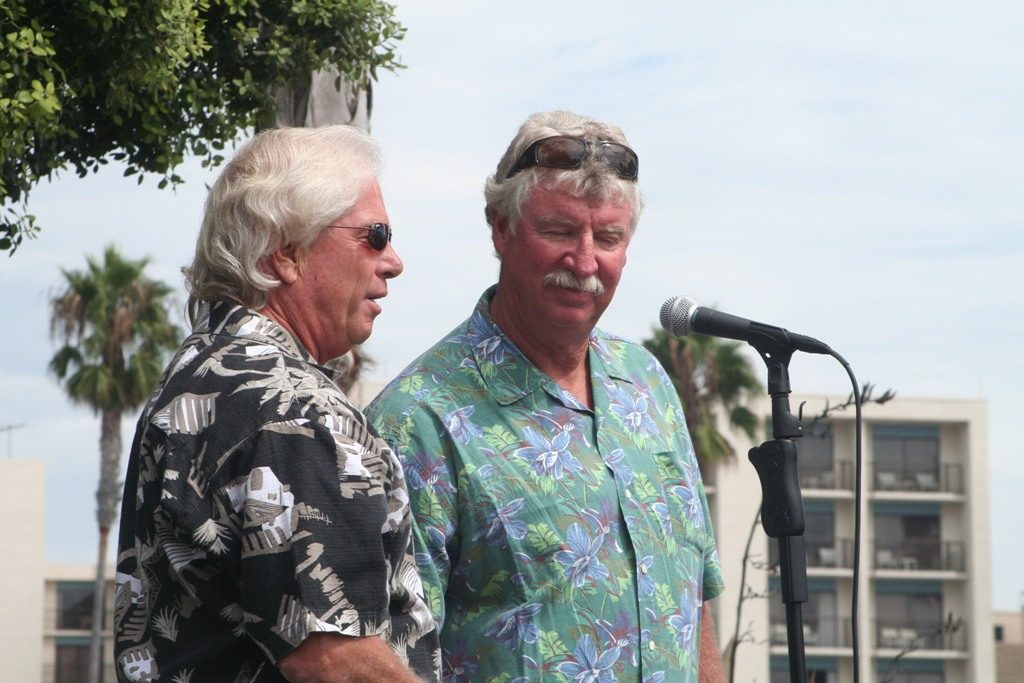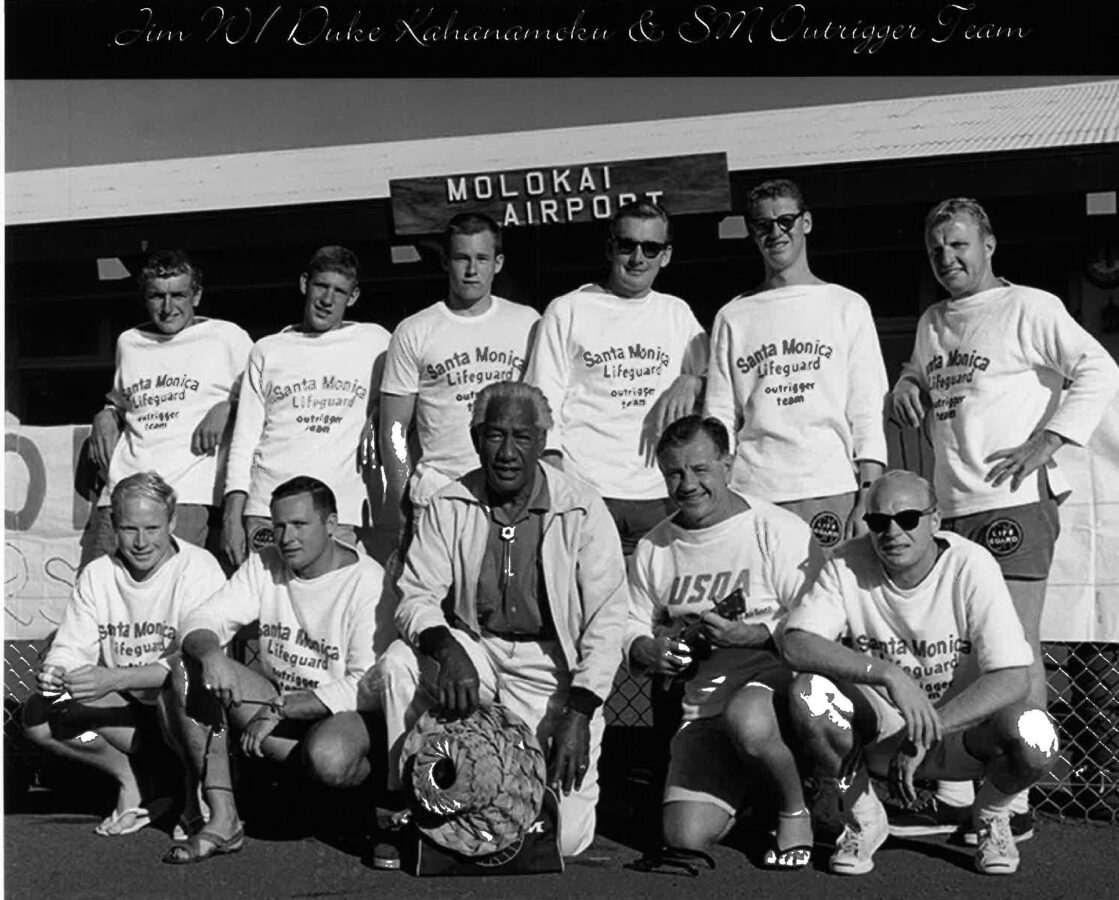
Jim Graham rode his first wave on his dad’s back, bellyboarding in front of their 21st Street, Hermosa Beach home. Graham was born in 1942 and his dad was just back from World War II. So he guesses he was three or four.
“My dad wore a single Churchill fin and would raise it in the air like a shark fin,” Graham said.
The first wave Graham rode standing up was also a tandem ride. He was 10 when his Los Angeles County Junior Lifeguard instructor Frank Tanner paddled him out on a kook box rescue board on the north side of the Hermosa Beach Pier.
After that first stand-up ride, Graham’s pursuit of life as a waterman was set. This Saturday, that pursuit will lead to his induction as a Pioneer in the Hermosa Beach Surfer’s Walk of Fame. The inductions will take place on the Hermosa Beach pier at 11 a.m. Former Manhattan Beach pro surfer Chris Frohoff and former surf film star Mary Lou McGinnis-Drummy, of San Clemente, will also be inducted
The young junior lifeguard began surfing on his own after finding a kookbox in the surfline.
He hauled it ashore, drained it, patched it and spent that summer dragging the board across the beach, to and from the water. The hollow, 12-foot, redwood board weighed more than he did.
By then, Graham had come to idolize a circle of older surfers and lifeguards, including Hal Ormondroyd and future Surfers Walk of Fame inductees Bob “Bergen” Bergstrom (whose family owned the 21st Street house the Graham family rented), Beecher Anderson, Stu Linder and Hap Jacobs. The crew sailed a catamaran off the beach that they had built and retired in the afternoons to a palm frond hut guarded by a Tiki god they had carved.
“Hermosa was still a small town with a hospital in the south end of town. After Labor Day Weekend, when the summer residents returned to their Pasadena and Los Angeles homes, there were just a few thousand residents left in town. We all knew each other,” Graham said.
Which meant everyone knew when Graham’s and and siblings Michael’s, Richard’s and Mary’s idyllic lives began to unravel in 1952, when his parents divorced.
Graham describe his mother Leone as bright, industrious and independent.
“Those qualities weren’t necessarily an asset in the male dominated world of the mid-fifties and early sixties. She was a single mom living in a small, two-bedroom one bath apartment, raising four children.”
When the 1955 school year began, and his mother was losing her fight with alcoholism, Catholic Charities stepped in with scholarships for Jim and Michael to attend St. John Bosco, a Catholic boarding school in Bellflower run by an order of Brothers known for strict discipline. Graham and his brother had previously attended American Martyrs School in Manhattan Beach. Sister Mary went to live with their grandparents in Westchester. Richard stayed with his mom in an apartment above a Manhattan Beach hardware store.
Through that periodl, Graham said, what sustained him was dreams of getting back to the beach. The dream was realized when the family of his best friend Brad Stevenson, took him in for the summers of 1955 and 1956. The two had met when he had attended Center School in Manhattan Beach.
“Brad’s family, even though they had three kids, saved my ass by taking me in during my 7th and 8th grade summers,” Graham said.
“By the time I entered Mira Costa High School my mom realized she had to get away from the South Bay and the surfers and volleyball players I idolized if she was ever going to stay sober. So, we moved to Santa Monica and I enrolled at Santa Monica High School.”
The uprooting proved fortuitous.
“I couldn’t have continued swimming at Mira Costa because it disbanded its swim team after my freshman year there.”
When Graham arrived at Samohi, he was a lean 6-foot-3 surfer whom Samohi coach Knute Clarked recognized from the previous year’s Mira Costa swim meets as a promising addition to his team.
“I had no money, no car and wasn’t very confident. The one thing that gave me encouragement was seeing my name in the Santa Monica Evening Outlook box scores after the swim meets,” Graham recalled.
After earning All American honors his junior year, his Santa Monica Junior Lifeguard instructor and legendary El Camino College swim coach Rudy Kroon encouraged the 17-year-old Graham to take the Santa Monica Lifeguard swim test.
He finished second out of 200 competitors and was assigned to Santa Monica Tower 2 on the beach at the foot of Ocean Boulevard, where Samohi kids camped out every summer.
“I was a different kid when I returned to campus for my senior year,” Graham said.
Another life changing experience at Samohi occurred the first day of his sophomore English class. The teacher was Andy Dimas. His family owned the Dimas Flower shop in Hermosa. He was a member of Mira Costa’s first graduating class and was in his first year of teaching. His students who were just a few years younger than he was. He assigned the class to write a two page story.
“He said, ‘Don’t worry about spelling or grammar. Just tell me a story.’ When he returned the papers he said he gave just two A’s and mine was one of them. He told me, ‘Your spelling is atrocious but you tell a good story.’ After that I started writing for the school paper.” Graham attributes is future success in marketing to the confidence Dimas gave him to put his ideas to paper.

The first fruits came in 1960, the year he graduated from high school.
“I wasn’t ready for college, so I started paddling with my fellow lifeguards,” he said.
The crew included that year’s Catalina Classic winner Tom Zahn and Kemp Aaberg and Mike Doyle, who finished first and second, respectively, in the stock division, just 30 seconds apart. Graham crossed the channel and reached the Redondo Barge before pulling out “due to mental exhaustion,” he said. Nutrition was not a part of the sport then and bonking was common.
“Following Catalina, Tom Moore, one of the older guards, who had spent time in Hawaii, said, ‘We’re all in shape. Let’s enter the Molokai Outrigger Canoe Race.”
Graham helped Moore convince Frank Donahue, a Santa Monica surfer, former Navy Frogman, future “Sea Hunt” creator and then-owner of a Hawaiian charter airline, to sponsor the novice outrigger team. The first ‘haole” team ever to enter the race placed third and more importantly, gave Graham and Doyle the opportunity to spend the winter surfing the North Shore. The North Shore, like the Hermosa Beach of his youth, was still a backwaters.
During this period, Bruce Brown, Bud Brown and Greg Noll were making movies that they showed on the middle school auditorium circuit.
“Bud Brown would knock on our door and say, ‘It’s 15 feet. I need someone to go out. So we ended up in a lot of early surf films,’” Graham said.
In 1965, Graham, then, the president of the Long Beach Surf Club, was named captain of the U.S. surf team that Catalina Swimwear sent to Lima Peru for what is regarded as the first international world surfing championship. The team included Doyle, a young David Nuuhiwa, Joyce Hoffman and Candy Calhoun. Doyle and Linda Merrill won the tandem division. Graham and partner Heidi Edwards placed second. Edwards was the wife of surfing great Phil Edwards.
A film of the trip, produced by Catalina Swimwear, shows the team wearing After 6 tuxedos and being welcomed at the presidential palace by President Fernando Belaunde Terry.
In 1963, popular lifeguard and Jacob’s Surf shop manager Tim Kelly was killed in a auto accident while returning from a surf trip to Trestles. Jacobs asked Graham to manage his shop.
“No one came to the shop in the mornings, so I changed the hours from the traditional 9 to 5 to noon to 8 p.m., which gave parents time to bring their kids in after work. And freed us to surf in the mornings.”

While working at Jacobs Graham received a call from KHJ TV weatherman Stan Richards. He was starting a Sunday afternoon show called “Surf’s Up.” He wanted Jacobs to provide half a dozen boards for the set. Graham saw a marketing opportunity and without consulting Jacobs, promised the boards.
Richards, who knew nothing about surfing, recognized in Graham the color commentator he needed for the surf clips aired on the show.
“I had been announcing surf contests and wasn’t bashful around a mic,” Graham said. He would serve as an associate producer and occasional co-host from 1964 to 1966. The nationally syndicated television would lead to countless announcing jobs for surf contests and lifeguard competitions. Graham was the master of ceremonies for the International Surf Festival from 1967 to 1984.
In 1967 Graham pitched National Airlines on the idea of surfers teaching its flyers to surf. The airline didn’t like the idea, but they liked Graham’s initiative and offered him a job in its Los Angeles marketing department.
“It was my first coat and tie job. I was working in the Tishman building at 6th and Flower St., downtown Los Angeles. It included flight privileges, so I was able surf with my family all over the world,” Graham said.
By then he was back living in Hermosa with his wife Jan, whom he married in 1963. The couple had two daughters, daughters Kirsten and Sydney. (Graham also has a stepdaughter Brooke Marie Oakley-Lopez.)
The corporate experience was followed by a decade of entrepreneurship that included a catering company, director of the officials for the International Co-Ed Volleyball League (IVA) and a junior lifeguard program for girls.
The girls junior guard program ended, he said, when Los Angeles County Supervisor Jim Hay’s wife learned the county junior guard program didn’t admit girls. “She was an ardent women’s libber.”
Parallel to Graham’s waterman activities was a lifelong involvement in volleyball.
“As kids, we’d surf in the mornings and when it got blown out we’d hang out at the beach and play mixed beach volleyball. We weren’t doing it for the competition. We were doing it for the girls,” he said.
Beach volleyball led him to playing indoor volleyball at Santa Monica City College on a 1964 team that included future Olympians Ernie Suwara (‘64), Butch May (‘68) and Hermosa native Bill Clemo (‘68). That year, the team defeated UCLA at the Air Force Academy in Colorado Springs to claim the NCAA Collegiate National Club Championships.
Refereeing for the Association of Volleyball Professionals (the AVP) kept him connected to the beach when at age 52, he moved to Durango, Colorado, after resigning his position as the Redondo Beach Harbor Department director of marketing and promotions.
“Durango is beautiful and similar to the Hermosa Beach I grew up in,” he said.
In the mountains, Graham did what kids who grow up in the mountains do. He became a ski instructor, a water rafting guide and, in a reluctant acknowledgment of his age, a member of the Durango Parks and Recreation Commission. He had been a Hermosa Parks and Recreation commissioner in the late 1970s and early 1980s.
“My friends and I had no idea growing up body surfing, belly boarding, matt surfing, board surfing, then travel surfing, lifeguarding and playing beach volleyball that we were living what would become an idealized cultural lifestyle. I think we were blessed not knowing it,” Graham said. ER










